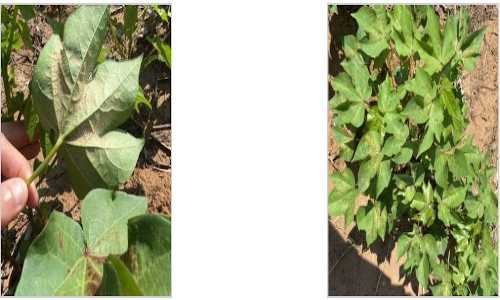By Scott Graham and Ronald Smith
The two-spotted spider mite, Tetranychus urticae, is an occasional economic pest of Alabama cotton. Adult two-spotted spider mites are 0.3 to 0.4 milliliters in size and may be red, yellow, or straw colored with two characteristic back black spots.
Immature two-spotted spider mites are smaller than adults and may be red or reddish yellow. These spider mites overwinter in plant litter or on weeds, and populations begin building on hosts as temperatures warm in late spring and early summer. The two-spotted spider mite life cycle heavily depends on temperature, and under optimum conditions, spider mites can develop from egg to adult in as few as 5 days.
Spider mite outbreaks in cotton begin from mites that developed on other hosts, such as weeds in ditch banks or within the field. Anecdotal evidence in Alabama suggests that spider mite issues have increased over the years as the adoption of reduced tillage systems has increased. Two-spotted spider mites can move into or throughout fields by crawling, being blown by wind or dust, or being carried by field scouts or equipment.
Populations of spider mites typically go unnoticed until environmental conditions become favorable for their development. Hot, dry conditions favor spider mite outbreaks, which often follow applications of broad-spectrum insecticides. Two-spotted spider mites feed on the underside of leaves, but injury symptoms are seen on the top of leaves. Spider mites feed by inserting their piercing and sucking mouthpart into the epidermal cells of leaves sucking the juices out of the plant.

Signs of spider mite feeding begin as white or yellowish stippling that develops into reddening or purpling of leaves along leaf veins. This injury may lead to reduced photosynthesis or, in severe cases, premature defoliation. Two-spotted spider mites may infest cotton and build to treatable levels any time from the seedling stage through cutout.
Scouting for spider mites can be done while scouting for major pests during the season by simply looking for signs of injury while walking through a field. If leaf stippling or reddening is observed, look on the underside of the leaf for mites or the characteristic webbing that they produce. A 10x hand lens is useful to confirm the presence of spider mites as they can be difficult to see with the naked eye.
Exposing the underside of leaves to the sun may agitate mites, causing them to move and making them easier to see. Also, look for mites one or two nodes above the most symptomatic leaves as they may have moved up to fresh leaves. Fields should be treated for spider mites when mites are widely distributed throughout the field and mottling of leaves is common, particularly if no rain is in the immediate forecast.
Populations of two-spotted spider mites can disappear as quickly as they appear in certain conditions. A fungus, Neozygites floridana, may develop after rainfall events leading to a crash in spider mite populations. If conditions return to hot and dry after rains, populations may build back and reach treatable levels.
One way to help reduce the chance of spider mite infestations is to avoid unnecessary applications of broad-spectrum insecticides that kill beneficial arthropods in the field. In some cases, no matter the insecticide use strategies, two consecutive weeks of hot, dry weather can be enough for mites to build to treatable levels. If controls are necessary, several options are labeled in Alabama. For infestations earlier in the season and on smaller cotton, low-to-mid rates of miticides often provide adequate control. As the cotton progresses through the bloom stage and plants become larger, higher rates may be required to achieve good coverage and adequate control. A list of currently recommended thresholds and miticides in the Alabama Cotton IPM Guide.
Source : aces.edu